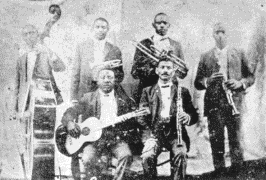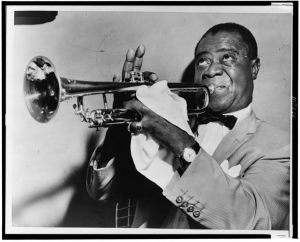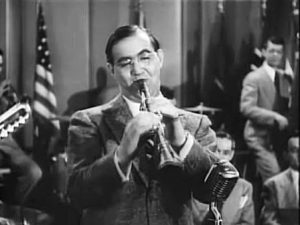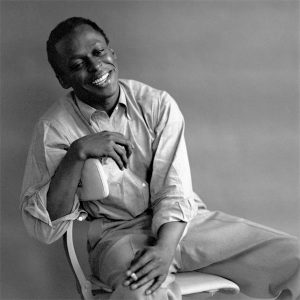14 Listening to Jazz Styles
Learning Objectives
- Identify representative music from various jazz styles.
- Identify important style traits of Early Jazz, the Blues, Big Band Jazz, Bebop, Cool Jazz, and Fusion.
- Identify important composers and performers of Early Jazz, the Blues, Big Band Jazz, Bebop, Cool Jazz, and Fusion.
By Jesse Boyd
Introduction
Please listen a little first. Honestly, it might be best to start at the end of this chapter and go backwards.
Video 14.1: Herbie Hancock “Cantaloupe Island” performed live in 1990
Jazz is a way of life. It’s a way of thinking. It’s a way of listening and speaking. It’s the way your soul sees the world. At the heart of Jazz is improvisation. And Jazzers improvise with style. Jazz means to be cool, to lay back, to play a little behind the beat. This style we call Swing. Swing is about momentum. It’s about playing together. Swing creates a force of moving ahead, moving on down the road to the next bit of coolness that we can experience and enjoy together.
Musically, Jazz is a language. The conversation began in New Orleans around 1900 and was the result of music from all over the world coming together at a magical time. The Mississippi River offered jobs and promise to people who packed up their families and moved to create a new life, a new beginning. Part of this new beginning was Jazz.
Jazz, even before it was known as Jazz, was an integral part of New Orleans. Music has been called the “universal language,” and it couldn’t have been truer than in New Orleans. Music was the thread that wove the new and diverse cultures together, and this music was improvised.
Some of the music that led to Jazz was Ragtime, Blues, Gospel, Marching Band, Classical, Caribbean, and African. Congo Square played an integral role because the slaves played drums there on Sundays in New Orleans.
Buddy Bolden (1877-1931)

Buddy Bolden was the first musician whose name was associated with Jazz. Please keep in mind that if the up-and-coming Jazz musicians had been labeled, they would’ve been called Ragtime musicians. After Buddy Bolden, some of the first generation of Jazz players were Jelly Roll Morton, Joe “King” Oliver, Sidney Bechet, the Original Dixieland Jazz Band, and of course, Louis Armstrong.
Louis Armstrong (1901-1971)

Louis Armstrong is the Father of Jazz. Prior to Armstrong, Jazz was a loosely assembled group or “collective” improvisation. This worked because each instrument had a role. Armstrong changed the arrangement by becoming the only soloist, while the rest of the band supported him. This transformation in Jazz might be compared to Classical music’s transformation from polyphony to homophony. Armstrong’s phrases made perfect sense and were complete. And there was so much joy. Even if you can’t see him play, listening to his music will make you smile.
Swing
The Swing Era is about the big band. The King of Swing was Benny Goodman. Other key figures are Duke Ellington, Glenn Miller, Count Basie, Cab Calloway, Tommy Dorsey, and vocalists Billie Holiday and Ella Fitzgerald. This is Top 40 music, a very slick show, and is all about the dancing.

Video 14.2: Duke Ellington and his Orchestra—Take the A Train (1962)
Bebop
Bebop is the beginning of “modern jazz.” This music was not for dancing but was instead intended for listening. Some musicians from the big bands felt that they were not really getting to play on the gigs, so they’d go to small clubs like Minton’s Playhouse and improvise until the wee hours of the morning. Charlie Parker, Dizzy Gillespie, Thelonious Monk, and Bud Powell are just a few of the Bebop musicians. Whereas Swing was about dance and boasted tight arrangements, Bebop asked you not to dance and was all about the solo. It was all about improvisation.

Video 14.3: Jazz Fundamentals: What Is Free Jazz?
In the 1950s after Bebop, Jazz branched out into Hard Bop, Modal, and in the ’60s, we played Free Jazz and Bossa Nova. Hard Bop is Jazz with a little Rhythm & Blues and Gospel. Modal Jazz is about the music in a slightly different way. Instead of playing off the chords, the improvisation is based on a mode, which is just another word for scale. The pinnacle of Modal Jazz is an album by Miles Davis called Kind of Blue. The musicians on this recording all deserve the highest recognition. It’s Miles on trumpet, John Coltrane on tenor sax, Cannonball Adderley on alto sax, Bill Evans on piano, Wynton Kelly on piano on Freddie Freeloader, Paul Chambers on bass, and Jimmy Cobb on drums.

Video 14.4: Miles Davis—”So What” from Kind of Blue
Free Jazz seeks to explore Jazz with few restrictions. The music could be based on a single phrase or melody, a set of chords (in no specific order), or maybe just an idea. Free Jazz is unbridled emotion. Bossa Nova, Jazz originating in Brazil, on the other hand, is some of the most beautiful, lyrical music that you’ll ever hear. And contrary to Free Jazz, which is instrumental, Bossa Nova often focuses on a vocalist delivering the gorgeous melody. Melodies are accompanied by a seamless series of magical chords, and the beat is nothing short of paradise.
Miles Davis shared the stage with several phenomenal pianists in the 1960s: Keith Jarrett, Herbie Hancock, and Chick Corea.
Fusion was a popular style of Jazz in the 1970s. It began with the Miles Davis recordings, In a Silent Way and Bitches Brew. Fusion is Jazz mixed with Rock & Roll, Rhythm & Blues, and is played on electric instruments. Many of the key players on Bitches Brew formed their own bands. Herbie Hancock started Headhunters, Chick Corea founded Return to Forever, John McLaughlin started The Mahavishnu Orchestra, and Wayne Shorter and Joe Zawinul formed Weather Report.
Video 14.5: Chick Corea, Herbie Hancock, John McLaughlin, Carlos Santana, et al.
In the early 1980s, the world was introduced to the Marsalis family from New Orleans. The father, Ellis, played piano (passed 4/1/2020), Branford plays sax, Wynton plays trumpet, Delfeayo plays trombone, and Jason plays drums. They are all extraordinary players and scholars of the music. Ellis played around the world but stayed in New Orleans and could be heard most Friday nights at Snug Harbor on Frenchmen St. in New Orleans. Wynton was the first musician to win Grammys in Classical and Jazz in the same year. His technique and mastery of the instrument are truly amazing. He is currently the music director of the Lincoln Center Jazz Orchestra in New York and was a chief contributor on Ken Burns Jazz and the recent Buddy Bolden movie, just to name a few. His style for quite a few years has been historical. A staple of his recent musical repertoire has been the music of Duke Ellington.
Branford played with Sting for a few years, led the Tonight Show Band for a few years, and now concentrates on his quartet. His music is some of the most innovative in Jazz. Delfeayo and Jason are brilliant as well. Ellis used to tell me that Jason has the most talent. You can hear them in New Orleans when they’re not on the road.
Piano players have always played significant roles in Jazz. In early Jazz, it was Jelly Roll Morton, then Duke Ellington and Count Basie in the Swing Era. Thelonious Monk and Bud Powell were pioneers in Bebop, and Bill Evans developed modality with Miles Davis. There are three pianists who played with Miles in the ’60s that went on to become icons in the Jazz world. These players are Herbie Hancock, Chick Corea, and Keith Jarrett.
Something to Think About
What if Jazz had emerged somewhere other than New Orleans? What are some possible differences? Would it even be Jazz?
Chapter Summary
Jazz has roots in European harmonies and African rhythms. Since its inception, it has been many things to many different people. To some, it’s dance music. To others, it provides a place to think. To yet others, it’s simply about emotion. Sometimes a listener might select a song to suit their emotion, and yet other times, the listener might want to pick a song that will change the mood.

